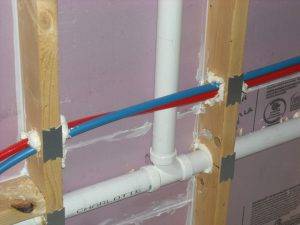How do you split a water supply line? Good question. Let’s go over how you can do it.
How to use a Flow Splitter
A Flow Splitter is used to split a water supply line into two or more smaller pipes, which are then connected back together at one end and have an outlet on the other end. The purpose of this device is to allow multiple users to share the same source of water without having to install separate lines from their house to the common tap. It also allows them to use less than what they would need if each had his own individual line running directly to the faucet. This saves money as well because there will be fewer connections in your home that could leak.

The most popular type of flow splitter uses a tee fitting with a valve inside when you want to split a water supply line. You’ll see these fittings all around town where people connect their garden hoses to city mains. They’re easy to make yourself by cutting off the bottom part of the hose and inserting a piece of PVC tubing into the hole. Then insert another piece of PVC tube into the first so that it extends outwards about 1/2 inch past the original opening. Now cut off the top half of the second section of hose leaving just enough length to reach the wall socket. Insert the new end of the hose through the hole in the tee fitting and tighten down the nut until snug. Finally turn the handle of the valve clockwise to open up the connection between the two sections of hose.
Before you split a water supply line, you may want to consider installing some sort of water shutoff valve near both ends of the system to control the flow of water and prevent any accidental leaks when not in use. A simple ballcock works great but you might prefer something fancier like a pressure-relief valve. These valves automatically close whenever the water reaches a certain level and keep the water flowing even after the user has turned off the spigot.
How to use a Pipe Cutter
To install your flow splitter you may need to use a pipe cutter Pipe cutters come in many different sizes depending on the size of pipe being cut. If you’ve never worked with a pipe cutter before, here’s a quick overview:
- Hold the tool steady while turning the wheel counterclockwise. When the blade starts to get dull, stop rotating the wheel and replace the blade.
- To remove material, hold the tool still and rotate the wheel clockwise.
- For larger cuts, increase the speed of rotation. Smaller cuts require slower speeds.
- Always wear safety glasses when working with tools.
- Never force the tool against the pipe; instead, push gently.
- Use only sharp blades. Dull blades cause uneven cuts.
- Keep the area surrounding the work clean. Dirt collects quickly and makes the job harder. Seal up the edges with epoxy putty
After completing a project, always wash hands thoroughly with soap and warm water. Washing helps reduce bacteria build-up. Don’t forget to label your piping projects. That way you won’t mix up old and new parts later on.
How to split a water supply line with a broken pipe
If you come across a broken pipe it’s going to make this job a lot more complicated First thing you should do is call someone who can help you fix it. Next step is to find out exactly what kind of pipe was damaged. There are three types of pipe materials commonly found in homes today: copper, plastic and galvanized steel, one of which will be found in all bubbling rock fountains,, one of which will be found in all bubbling rock fountains,. Each material requires its own set of skills to repair properly. Here’s a brief description of each type of pipe:
Copper – Copper plumbing systems were once very common throughout North America. However, due to high maintenance costs and corrosion issues, copper piping is now rarely seen except in older buildings. Today, copper is mostly limited to commercial applications such as restaurants and hotels.
Plastic – CPVC stands for cross-linked polyvinyl chloride. In addition to being flexible, durable and inexpensive, CPVC is resistant to chemicals and heat. Most residential installations consist of small diameter PEX piping installed under sinks and tubs. Larger diameters are often used for kitchen appliances and laundry equipment.
Galvanized Steel – Galvanizing is a process that coats metal surfaces with zinc. Zinc protects metals from rusting and corroding. Because of this property, galvanized steel is widely used for outdoor structures including fences, sheds, decks and patios.
Once you know what kind of pipe was affected, you’ll need to decide whether you’d rather hire a professional plumber or try fixing it yourself.
Step-by-Step
If you decide to do it yourself, check this video for clear visual information.
